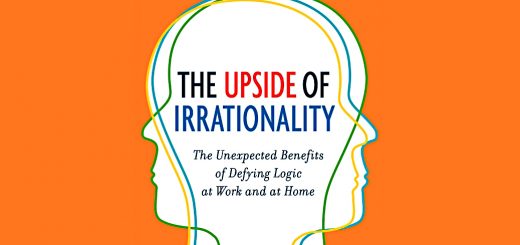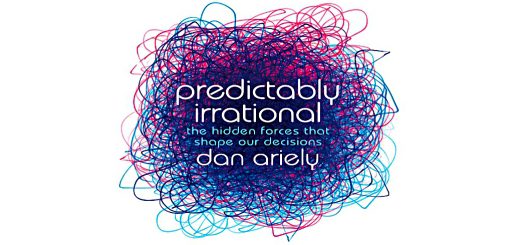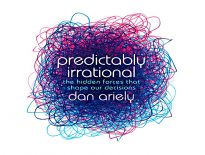Predictably Irrational 3 – Options, Expectations and Placebo

Today’s post is our third visit to the book Predictably Irrational by Dan Ariely.
Options
Chapter 8 is about options.
Dan begins with the story of Xiang Yu, who in 210 BC burned his army’s boats and pans in order to focus their minds on victory.
- They won nine battles in a row.
Most people don’t like to close any doors or burn any bridges (or boats).
- We like to keep our options open.
We buy insurance we are unlikely to use, and tech with high-end features we will never need.
- Parents support their children in every imaginable activity, rather than just one.
- And as Dan points out, almost nobody who buys an SUV needs one.
All of this takes time and money away from what is really important.
To investigate why we do this, Dan and a colleague used an experiment based around a computerised “door game”.
As the program booted up, three doors appeared on the computer screen: one red, the second blue, and the third green. Once they were in a room, each subsequent click would earn them a certain amount of money.
So participants needed to quickly figure out which room had the biggest payoff.
- To make it harder, switching rooms cost one click (out of 100), in the same way that entering their first choice of room did.
A sensible strategy might be to sample each room for a few clicks, then decide on which one you felt was the best, and commit to it for the rest of the experiment.
But in the real world, the options you ignore (potential partners, say) will disappear.
- So the game was modified such that any room that was ignored for 12 clicks would disappear forever.
Watching the other doors shrink towards nothingness proved distracting to the subjects, and they began to flit from room to room.
In their frenzy to keep doors from shutting, our participants ended up making about 15 percent less than the participants who didn’t have to deal with closing doors. They could have made more money by picking any room and staying there for the whole experiment.
Introducing a charge (in dollars, not just a click) didn’t change the behaviour of the subjects.
- Nor did practice runs
- Nor did telling them the average rewards within each room
- And nor did even making the disappearance of a door inconsequential, in that it could be restored with a single click (“reincarnation”).
They still could not tolerate the idea of loss, and so they did whatever was necessary to prevent their doors from closing.
We are continually reminded that we can do anything and be anything we want to be. The problem is in living up to this dream.
How many times have we bought something on sale not because we really needed it but because we could never have it at that price again?
And of course, people spend too much time in the office and too little doing what they really want to.
Small doors, of course, are rather easy to close. But the bigger doors (or those that seem bigger) are harder to close. Doors that are tied to our dreams are also hard to close.
What people need to do is take into account the consequences of not deciding.
- The lost time and money, or in the case of the donkey stuck half-way between two bales of hay, starvation.
Even flipping a coin can help (when there are only two choices).
- Particularly if you ignore the result, and focus on which face of the coin you were hoping would land uppermost.
Expectation
Chapter 9 is about how the mind gets what it expects.
Dan starts by reminding us that football fans who support different teams interpret the play (an in particular, refereeing decisions) very differently.
- This phenomenon has spread to politics in recent years – perhaps 20 years ago in the US, and as little as five years ago here in the UK.
Dan’s experiments to investigate expectations (or prejudice, if you prefer) involved beer.
- Subjects were given samples of both Budweiser and Budweiser plus a bit of balsamic vinegar (later versions used the rather better Sam Adams beer as a base).
Sometimes they were told about the adulteration, and sometimes they were not.
Without foreknowledge about the vinegar, most of them chose the vinegary MIT Brew. But when they knew in advance that the MIT Brew had been laced with balsamic vinegar, they wrinkled their noses and requested the standard beer instead.
A follow-up experiment involved coffee and a lot of potential additives.
- regular – milk, cream, “half-and-half”, white sugar, brown sugar, and
- unusual – cloves, nutmeg, orange peel, anise, sweet paprika, and cardamom
None of our odd condiments were ever used.
The point of the experiment was that the condiment containers were varied.
Sometimes we placed them in beautiful glass-and-metal containers, set on a brushed metal tray with small silver spoons and nicely printed labels. At other times we placed [them] in white Styrofoam cups, the labels handwritten in a red felt-tip pen. [Or] we cut the Styrofoam cups shorter, [and] gave them jagged, hand-cut edges.
When the odd condiments were offered in the fancy containers, the coffee drinkers were much more likely to tell us that they liked the coffee a lot. When the coffee ambience looked upscale, the coffee tasted upscale.
The third experiment returned to beer to test whether knowledge informs us, or actually changes our experience.
- Some subjects were told about the vinegar before they drank, and some after.
The students who found out about the vinegar after drinking the beer liked the beer much better than those who were told about the vinegar upfront.
So the knowledge does not change our sensory perceptions, merely what we think about them.
- In a fourth variation, those told after drinking were even willing to add their own vinegar to a second beer.
These results explain the elaborate descriptions of dishes on restaurant menus.
- And even the presentation in the plate.
In fact, this effect is the basis of all marketing, from movie reviews to brand reputation.
- It explains, for example, why people prefer Coke to Pepsi.
Next, Dan looks at stereotypes.
Stereotypes are not intrinsically malevolent. They provide shortcuts in our never-ending attempt to make sense of complicated surroundings.
Of course, the problem with stereotypes is that though they may be true for a group as a whole, they will not be true for every member of that group.
Further:
Stereotyped people react differently when they are aware of the label that they are forced to wear (in psychological parlance, they are “primed” with this label).
To investigate this, Dan refers to an experiment involving subjects who are affected by two stereotypes at once – Asian-American women.
- Asian-Americans are held to be gifted in mathematics and science
- Women are felt to be weak in mathematics.
The women were primed before a maths exam by either being asked questions related to gender, or questions related to race (but not both).
Those who had been reminded that they were women performed worse than those who had been reminded that they were Asian-American.
Priming also works outside of stereotypes.
One study had participants complete a scrambled-sentence task. For some , the task was based on words such as aggressive, rude, annoying, and intrude. For others, the task was based on words such as honor, considerate, polite, and sensitive.
Part two of the experiment involved them being taken to a second lab where the experimenter was struggling to explain things to a subject (actually, a stooge).
Those who had worked with the set of polite words patiently waited for about 9.3 minutes before they interrupted, whereas those who had worked with the set of rude words waited only about 5.5 minutes before interrupting.
A similar experiment priming “elderly”, using words such as Florida, bingo, and ancient.
- The primed subjects (undergraduates, not old people) walked more slowly down the hallway when they were leaving than did the control group.
The usefulness of expectation – or what we might also call context – is that it allows us to fabricate the signal when it is obscured by noise.
- But sometimes the signal we create will be wrong.
In investment, the most obvious example is the sorting of companies into good and bad.
- This might arise naturally from their past performance but is also sometimes compounded by our personal preferences for their products and services, or even from our excitement at meeting the firm’s directors.
But usually, it comes simply from the fact that we own the stock.
- We need to believe that our historic purchase was a good decision.
This is the endowment effect again.
The problem is that future newsflow will then be evaluated against our prior classification – our prejudice.
- And we will hang on to our losers for too long.
Placebo
Chapter 10 explores why 50-cent aspirins work better than 1-cent aspirins.
Placebos were originally fake mourners hired to sob at funerals, but by the late eighteen century it had become a medical term.
- Dan begins by covering a couple of examples of placebo surgery (for heart pain and arthritic knees) which demonstrated that the accepted (and lucrative) existing procedures were not needed.
Placebos run on the power of suggestion. They are effective because people believe in them. You see your doctor and you feel better. You pop a pill and you feel better.
The attention from a doctor is helpful, but so is Pavolivian conditioning that releases chemicals associated with previous occurrences of the same situation.
- And so, according to Dan, is the price.
Dan’s first experiment involved receiving electric shocks before and after taking a new painkiller (“Veladone-Rx”).
Almost all [participants] reported less pain when they experienced the electrical shocks under the influence of Veladone. Very interesting – considering that Veladone was just a capsule of vitamin C.
In the next version, the brochure describing the drug was changed, with the original $2.50 per dose price scratched out and replaced by 10 cents.
- Now only half of the participants reported pain relief.
People who had recently experienced pain, and depended on “quality” medication, were less likely to believe in the cheap placebo.
- Dan also notes that students buying expensive cold medicine report better results than those buying cheaper medicine.
A follow-up experiment used a caffeine-based energy drink, with the subjects tested on anagrams.
- Half the students paid full price, half paid a third of the regular price.
Students who paid full price scored as well as the control group (which had no energy drink).
- Those who drank a cheap drink actually performed significantly (28%) worse than the controls.
Adding a statement to the quiz book that the drink should improve performance resulted in higher scores for both the expensive and the cheap drink consumers.
- But the hype worked better on those with the full price drinks.
If we see a discounted item, we will instinctively assume that its quality is less than that of a full-price item – and then in fact we will make it so. Consumers who stop to reflect about the relationship between price and quality are far less likely to assume that a discounted drink is less effective.
The placebo effect raises important questions for medicine (though not particularly for investment, though it probably underpins the success of Apple).
The idea of sacrificing the well-being and perhaps even the life of some individuals in order to learn whether a particular procedure should be used on other people at some point in the future is indeed difficult to swallow.
In the United States very few surgical procedures are tested scientifically. For that reason, we don’t really know whether many operations really offer a cure, or whether, like many of their predecessors, they are effective merely because of their placebo effect.
America already spends more of its GDP per person on health care than any other Western nation. How do we deal with the fact that expensive medicine (the 50-cent aspirin) may make people feel better than cheaper medicine (the penny aspirin).
Do we indulge people’s irrationality, thereby raising the costs of health care? Or do we insist that people get the cheapest generic drugs (and medical procedures) on the market, regardless of the increased efficacy of the more expensive drugs?
Conclusion
That’s it for today.
- We’re three-quarters of the way through the book, so there will be one more article in this series, plus a summary.
Until next time.















